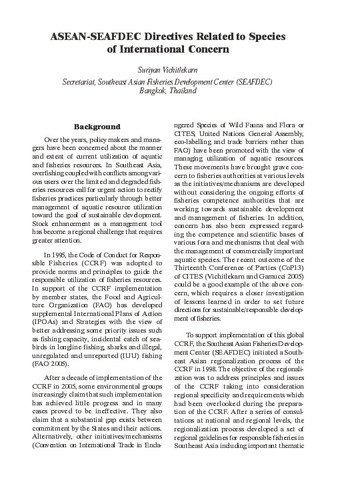Status and prospects of aquaculture of threatened echinoderms in the Philippines for stock enhancement and restocking
- Global styles
- MLA
- Vancouver
- Elsevier - Harvard
- APA
- Help

Date
2006Page views
7,050ASFA keyword
AGROVOC keyword
Taxonomic term
Metadata
Show full item record
Share
Abstract
Echinoderms are either specifically targeted by gleaners and divers, or form part of the multispecies invertebrate fishery in many coastal areas in the Philippines. The existence of a local sea urchin market in northern Philippines (e.g., Pangasinan, La Union) benefits many coastal families that depend on this fishery for subsistence. In Bolinao, Pangasinan, over 40 families are reportedly dependent on this fishery. Major sea urchin species collected include Tripneustes gratilla, Diadema spp. and Salmacis spp. In the case of holothurian fishery, with over a century of fishery history for holothurians, at least 25 species mostly belonging to the families Holothuriidae and Stichopodidae are commercially important (Schoppe 2000). While there may be local consumption of both fresh and dried products, the latter are largely exported. Echinoderm fishery is dependent on wild stock. The high demand far exceeding supply, good global market prices and their biology (e.g., slow mobility, shallow water benthic habitat) render them vulnerable to overexploitation. The contribution of echinoderm products to the Philippine economy is substantial. The relative contribution of echinoderm products to the income and socio-economic well-being of fisherfolk who collect these invertebrates is undocumented. However, it has been noted that middlemen, especially local buyers who sell trepang in Manila and Manila-based traders-exporters monopolize the profits (F. Nievales, unpublished data). Products from both echinoderm groups remain in short supply in the country and so trading, limited only by declining natural stock, continues to be lucrative.
Suggested Citation
Nievales, M. F. J., Juinio-Meñez, M. A., & Bangi, H. G. (2006). Status and prospects of aquaculture of threatened echinoderms in the Philippines for stock enhancement and restocking. In J. H. Primavera, E. T. Quinitio, & M. R. R. Eguia (Eds.), Proceedings of the Regional Technical Consultation on Stock Enhancement for Threatened Species of International Concern, Iloilo City, Philippines, 13-15 July 2005 (pp. 61-69). Tigbauan, Iloilo, Philippines: Aquaculture Department, Southeast Asian Fisheries Development Center.
Type
Conference paperISBN
9789718511794
Related items
Showing items related by title, author, creator and subject.
-
Fisheries, aquaculture and stock enhancement in Lao PDR
Choudara, Hanh (Aquaculture Department, Southeast Asian Fisheries Development Center, 2006)Fisheries development in Lao PDR is confined to inland fisheries development and sustainable freshwater aquaculture including culture-enhanced capture fisheries and fishery-enhanced aquaculture. Given the potential of ... -
Potentials and prospects of Southeast Asian eel resources for sustainable fisheries and aquaculture development
Siriraksophon, Somboon; Ayson, Felix G.; Sulit, Virgilia T. (Secretariat, Southeast Asian Fisheries Development Center, 2014)The world demand for river eels has been increasing mainly because of the market expansion of some delicacies such as the kabayaki (broiled eel with sweet soy sauce) in East Asia. While most of the world’s eel production ... -
ASEAN-SEAFDEC directives related to species of international concern
Vichitlekarn, Suriyan (Aquaculture Department, Southeast Asian Fisheries Development Center, 2006)To achieve sustainable fisheries for food security in the ASEAN region, the Resolution (RES) and Plan of Action (POA) urge the Member Countries to rectify their fisheries practices through improvement of existing fisheries ...






